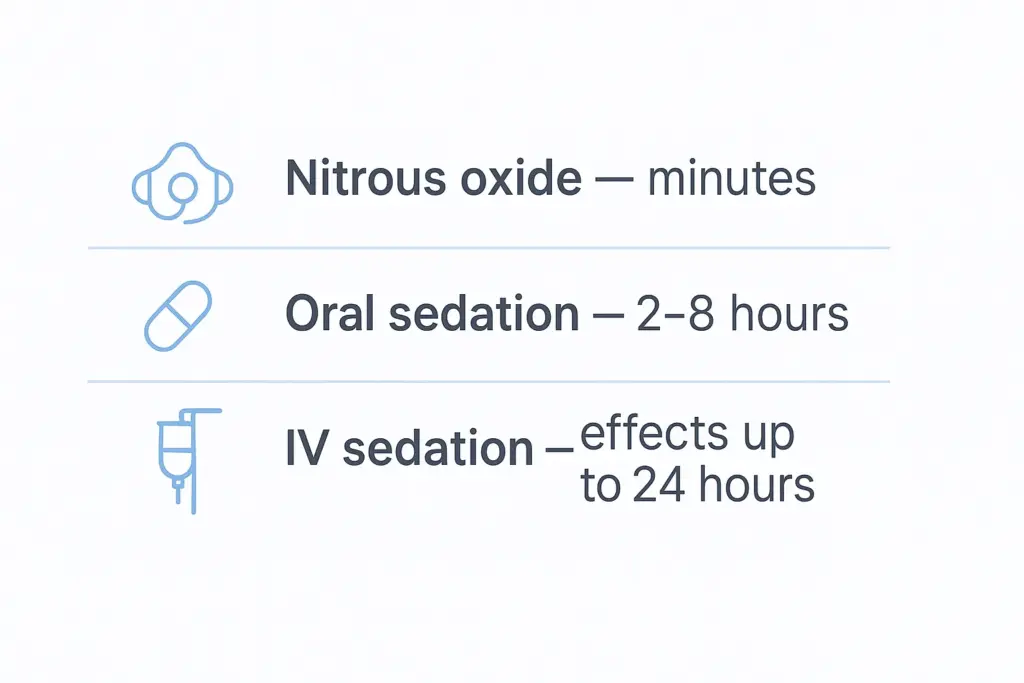Dental sedation supports comfortable, well-controlled care for anxious patients who have a strong gag reflex or require longer procedures. In practice, how long dental sedation lasts depends on the method: nitrous oxide wears off within minutes once the gas stops; oral tablets begin working in 30–60 minutes and last several hours; IV sedation acts quickly, with about an hour in on-site recovery and reduced alertness that can persist for up to 24 hours.
Throughout, monitoring is continuous, and patients should avoid driving, operating machinery, or making important decisions for at least 24 hours after oral or IV sedation.
What dental sedation feels like during treatment
With conscious techniques (nitrous oxide, oral tablets, IV medicines), patients feel calm and detached from surrounding activity. Time often seems quicker. Memory may be patchy afterwards, normal with some medicines. Local anaesthetic is still used at the treatment site to keep the area comfortable.
Types of dental sedation and how long each one lasts after treatment

Nitrous oxide (laughing gas)
Takes effect within minutes and typically clears within minutes after the gas flow stops, often assisted by a brief oxygen flush. Many adults can return to routine activity the same day if their dentist agrees.
Oral conscious sedation (tablet medication)
A prescribed tablet taken shortly before the appointment makes patients drowsy but responsive; memory may be hazy afterwards. Onset is usually 30-60 minutes. Effects commonly last several hours, and some people feel slightly “woolly” until the next morning. An escort is required; avoid driving or making important decisions for the rest of the day.
Intravenous (IV) conscious sedation
Medication is given through a small cannula; patients are relaxed, breathing on their own, and able to follow instructions. Expect around an hour in the practice recovery area. Residual effects can influence alertness and coordination for up to 24 hours, so plan a quiet day at home with supervision.
General anaesthesia (GA)
Used selectively in hospital day-surgery settings when clinically indicated. Patients are fully unconscious with specialist airway support and monitoring. Many people wake within an hour, but grogginess and reduced concentration can last through the day. Discharge requires a responsible adult to take the patient home and stay with them.
IV dental sedation recovery and how long dental sedation lasts before driving
A safety-first rule is no driving for at least 24 hours after IV sedation. Even when individuals feel clear, reaction time and judgement can be subtly impaired. Arrange transport to and from the clinic, postpone legal paperwork, and keep domestic tasks light until the next day.
Pre-appointment checklist (fasting, escorts, and transport)
- Follow fasting instructions if advised for IV/GA (timings for food and clear fluids)
- Confirm a responsible adult can accompany you, drive you home, and stay for the advised period
- Do not plan to drive; pre-book a taxi or have your escort drive
- Wear loose layers and slip-on shoes; bring inhalers or medical devices plus a list of medicines and allergies
What happens on the day of sedation
Arrival and checks
The clinician confirms medical history, medicines, and consent.
Monitoring
A fingertip probe tracks oxygen levels, a blood-pressure cuff is used, and sometimes ECG leads are applied.
Sedation begins
- Nitrous oxide: breathed via a soft mask; calmness builds within minutes
- Oral sedation: the tablet is timed so you’re relaxed on arrival or shortly after
- IV sedation: a small cannula is placed; medicine is titrated to comfortable drowsiness
Treatment and recovery
Local anaesthetic keeps the site comfortable while you remain responsive. You’ll rest post-procedure until the staff confirms you’re safe to go home with your escort.
Aftercare from the first hour to the next morning
First hour
Stay seated or lying down until advised to stand. Sip water if allowed. Eat something soft when your appetite returns and nausea settles.

The rest of the day
Keep activity light with sofa rest, short indoor walks, and prescribed pain relief if needed. Avoid alcohol, online purchases, signing documents, or other decisions requiring judgment. If you’re concerned out of hours, ouremergency dentist page explains how urgent care is arranged.
The following morning
Most people feel significantly clearer after sleep. Start with light tasks. If your role involves driving, operating machinery, or working at heights, confirm the return-to-work timing with your clinician. The 24-hour rule (no driving or important decisions after sedation/anaesthesia) is echoed in Guy’s and St Thomas’ instructions after anaesthetic or sedation.
Who is a good candidate, and who should be cautious
- Medical history: heart or lung disease, sleep apnoea, liver/kidney conditions, neurological issues
- Current medicines and alcohol: disclose fully to avoid interactions
- Pregnancy and breastfeeding: timing and alternatives are considered carefully
- Previous experiences and allergies: note any reactions or concerns
- Anxiety level and procedure complexity/duration: technique and dose are tailored accordingly
If work is safety-critical or you’re a primary carer, schedule sedation on a day that allows recovery without pressure.
Memory and awareness during and after sedation
With oral or IV sedation, many patients recall fragments, voices, brief instructions, or sometimes very little. This reduced memory is expected and can help limit anxiety without removing responsiveness. Trained staff remain present and monitor patients throughout.
Choosing the right sedation for common procedures
- Hygiene visit with marked anxiety: nitrous oxide often suffices, fast on, fast off.
- Multiple fillings or a longer restorative session: oral sedation supports comfort with a manageable recovery; for broader planning, see our guide to restorative dentistry.
- Implants, surgical extractions, and longer surgical sessions: IV sedation is commonly selected for deeper relaxation.
- Complex oral surgery when conscious sedation isn’t suitable: GA in a hospital day-surgery unit may be indicated.
For patients planning longer or surgical care, Chatsworth Dental can discuss appropriate sedation pathways, explain recovery timelines in plain language, and coordinate appointments to ensure transport and aftercare are arranged before the treatment day.
Quick answers to common questions
How long does dental sedation last overall?
From minutes (nitrous oxide) to several hours (oral), with up to 24 hours of reduced alertness after IV or GA. Plan transport, supervision, and a quiet day.
When can you eat again?
Follow the dentist’s instructions. After conscious sedation, many people can sip water soon and eat a light meal later once fully awake and not nauseous.
When can you exercise?
After nitrous oxide, often the next day, if you feel well. After oral or IV sedation, keep activity minimal on the day and reintroduce exercise when you feel steady and the clinician agrees.
Is sedation safe?
For suitable patients, with trained teams, sedation has a strong safety record. Pre-assessment tailors technique and dose to the patient’s health, medicines, and procedure.
Final thoughts
A clear plan, realistic timelines, and a responsible escort make sedation straightforward. If you’re weighing options or want tailored guidance on how long dental sedation lasts for your treatment, book a consultation with Chatsworth Dental to review medical history, choose the most appropriate sedation route, and map out recovery and transport so the day runs smoothly.

